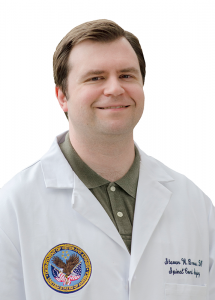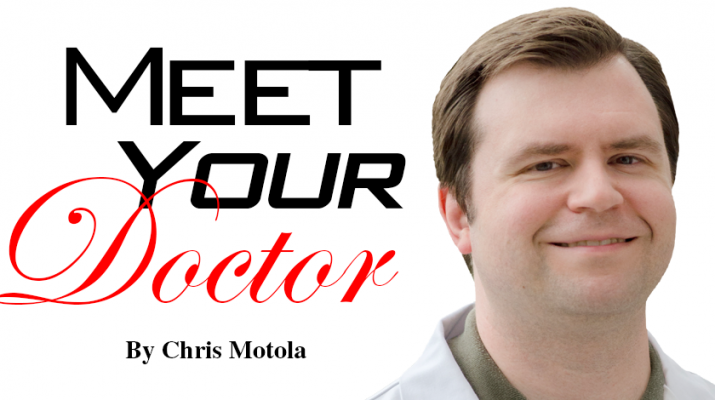New chief of the spinal cord injury and disabilities service at Syracuse VA talks about latest treatments in the field, has plans to greatly expand services locally
By Chris Motola
 Q: Can you give us a sense of what your role is as chief of spinal surgery at the Syracuse VA?
Q: Can you give us a sense of what your role is as chief of spinal surgery at the Syracuse VA?
A: This is a spinal cord injury center. The VA separates spinal cord injury into its own service. It’s a service that provides comprehensive care for veterans with spinal cord injuries and a variety of other disorders such as ALS, multiple sclerosis and a variety of other spinal cord-related neurological conditions. Our services are set up for both acute and lifelong care of veterans. Our service at the Syracuse VA started fairly recently, in 2013. It’s now rapidly expanding to provide additional inpatient and outpatient services to veterans with spinal cord injuries.
Q: Are you primarily dealing with war injuries?
A: It’s a very interesting group of people we serve. There are certainly people who have been injured during the course of their military service. There are also people we’ve served who have injuries that are service-connected but who may not have received a battlefield injury. We also serve veterans who have been injured after their time in the service from more mundane traumas like falls. Also, the population of spinal cord injury patients has been aging, so we’re treating a lot more older veterans than we have in prior years. That’s also in part due to advances in acute care which has resulted in an aging spinal cord patient population.
Q: A spinal cord injury seems like one of the most devastating traumas you can sustain. What can we do now to help patients with those injuries?
A: We have a lot of exciting research going on in the field of spinal cord injury. My own research is in the application of functional electrical stimulation (FES). My own research is in using FES to treat pelvic dysfunction, which includes bladder and erectile dysfunction due to spinal cord injury. There have been studies showing that patients rate sexual dysfunction and bowel and bladder dysfunction as the most important problems to manage. We have an exciting new $1.6 million research grant to apply electrical stimulation to help people with neurogenic bladder and prevent urinary incontinence. It’s a non-invasive technology, so it’s a surface electrical stimulation. We’re looking to actively enroll veterans to see if we can help them manage their bladders more effectively. There are other exciting things going on here. We’re expanding the number of inpatient beds for spinal cord injury patients from 20 to 30. We’re building a full outpatient clinic to provide tele-health services in rural areas. We’re also hiring 70 new positions to serve all these needs, including four additional physicians.
Q: With the electrical stimulation, is that something you apply periodically? Consistently? Is there a battery? Or is it a larger device?
A: Excellent question. We’re developing a wireless technology that doesn’t require a lot of electricity, so there is a battery. It’s a device that the patient can apply to their surface of the skin. It helps inhibit the bladder to prevent leakage. It can be used continuously or intermittently. We recently published a paper that shows the stimulation is well-tolerated either in people who still have sensations, so there’s no pain or anything like that.
Q: Why does the VA separate spinal injury services?
A: So we have the Paralyzed Veterans of America. It’s a group that advocates for veterans with spinal cord injuries. That’s they’re primary focus. So, separating the service provides a lot of benefits for veterans. We’re able to get a lot of the best equipment and brand new medications. We have robotic exoskeletons as well that some of their veterans are trying out that can allow them to walk even if they have no use of their legs. We also have robotic feeding devices and other advanced prosthetic technologies.
Q: Does actual repair of the spinal cord look possible?
A: There’s ongoing research into stem cells and nerve grafting. While the research I do is very important, neural regeneration research is ongoing and very important.
Q: You mentioned the staff increases. What kinds of services will they be bolstering?
A: It’s for all kinds of spinal cord-related treatment. They may come in for annual examinations. They can also get wound care and be treated for issues they’re more likely to have like pressure ulcers. We’re also able to do inpatient and outpatient Botox injections to treat spasticity. The increased capacity will allow us to treat a lot of patients with spinal injuries. The tele-health services are going to be exciting. Upstate New York is very rural, so this will allow us to check on a lot of our patients remotely. With the growth of our outpatient services, we’ll also be providing primary care for our spinal cord injury patients.
Q: How does the tele-heath monitoring work?
A: We have three-dimensional wound care technology that can map a wound remotely, in addition to more traditional technology like video conferencing. This allows us to see patients more often who live far away and may have a hard time coming in due to their spinal cord injuries.
Lifelines
Name: Steven W. Brose, D.O.
Position: Chief of the Spinal Cord Injury and Disabilities Service at Syracuse VA Medical Center. Most recently served as medical director of the Spinal Cord Injury Outpatient Clinic at the Louis Stokes VA Medical Center and as professor of specialty medicine at Ohio University
Hometown: Athens, Ohio
Education: Doctor of Osteopathic Medicine degree in 2005 from Ohio University. He then proceeded with residency training in physical medicine and rehabilitation at the University of Pittsburgh Medical Center, where he also served as chief resident and then spinal cord injury fellow. Board-certified in both physical medicine and rehabilitation and spinal cord injury medicine
Affiliations: Syracuse VA; SUNY Upstate Medical University
Organizations: Serves as associate editor of both the American Journal of Physical Medicine and Rehabilitation Journal of Spinal Cord Medicine, and is an active participant of the research and awards committee at the American Spinal Injury Association
Family: Married, two sons
Hobbies: Martial arts; chess; weightlifting.

